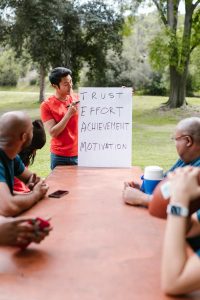Using Appreciative Inquiry in Your Leadership Practice
 In our leadership practices, we often find ourselves focusing on questions like “what is wrong?”, “what needs to be fixed?” or “what are the problems?”. It is rare for us to seek information about what things are working well for our patients or what in the workplace keeps staff engaged and inspired. Appreciative inquiry is a different model of decision-making and planning. The model is based on the assumption that the questions we ask will tend to focus our attention in a particular direction. If our focus is always problem-oriented then we are focused on dysfunction. We may fail to recognize the strengths in our organizational culture that can be used to help move us forward. Appreciative inquiry attempts to use ways of asking questions and envisioning the future in order to foster positive relationships and build on the present potential of a given person, organization or situation.
In our leadership practices, we often find ourselves focusing on questions like “what is wrong?”, “what needs to be fixed?” or “what are the problems?”. It is rare for us to seek information about what things are working well for our patients or what in the workplace keeps staff engaged and inspired. Appreciative inquiry is a different model of decision-making and planning. The model is based on the assumption that the questions we ask will tend to focus our attention in a particular direction. If our focus is always problem-oriented then we are focused on dysfunction. We may fail to recognize the strengths in our organizational culture that can be used to help move us forward. Appreciative inquiry attempts to use ways of asking questions and envisioning the future in order to foster positive relationships and build on the present potential of a given person, organization or situation.
A Case Example – Promoting Staff Engagement in their Work
For many units today, lack of nursing staff engagement is a major issue. But you will notice on any unit – there are some staff who are very engaged while others are not. The way that most organizations study engagement is to ask staff questions that are focused on their level of engagement and dissatisfaction. Appreciative inquiry would instead focus on what factors keep staff engaged in their work and on their units. Stephanie Judy and Susan Hammond recommend a 5 Step process sometimes called a 5-D cycle.
- Define the topic– which in this case would be staff engagement.
- Discover – discovery in appreciative inquiry is usually done through interviews versus online surveys or questionnaires. The interviews to study staff engagement could be done by a leader or perhaps by members of a professional practice council. In the interviews, you would look for stories about the group at their best and dreams that staff members might have to improve their units. Some examples could include the following:
- Tell me about a time when you felt very engaged in your work and excited about what you do professionally?
- What do you value most about this unit and the team you work with?
- When does this unit and staff function at its best?
- If you had 3 wishes that you would like to see happen to make this unit better – what would they be?
After finishing the interviews, you analyze what themes have been raised and what key factors, values and resources seem to account for successful staff engagement.
- Dream – put together the collective dreams of staff and a desired future for the unit to promote the engagement of all staff.
- Design – have staff begin to define the values, ideals and actions that need to happen to promote more effective staff engagement.
- Deliver – identify some key action steps that you as a leader and the unit will take to build a unit that will promote staff engagement.
Your focus as the leader in this process is to look at your team when it is at it’s best and identify actions that will promote success. It allows you as a leader to support and reinforce the strengths in your environment that keep staff engaged. Appreciative Inquiry takes the focus off of what is wrong – an approach that can lead staff to feel that their unit is full of problems that can’t be solved. Instead, it promotes optimism and hope that the unit has many strengths that can be built on.

